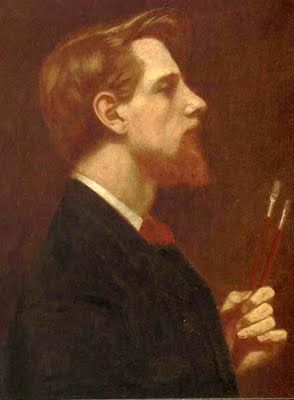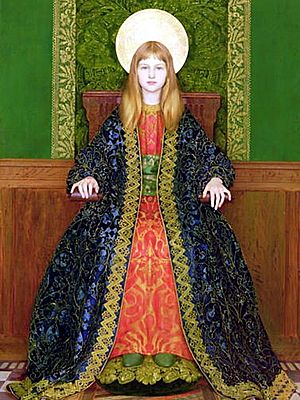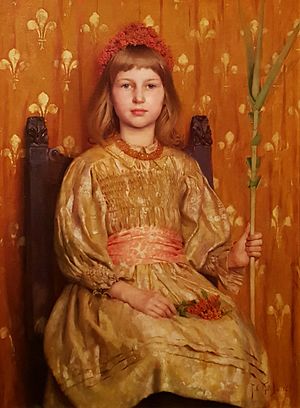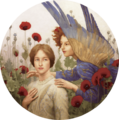Thomas Cooper Gotch facts for kids
Thomas Cooper Gotch (1854–1931) was an English painter and book illustrator. He is often linked to the Pre-Raphaelite art movement. His brother, John Alfred Gotch, was a famous architect.
Gotch studied art in London and Antwerp. He then married fellow artist Caroline and they studied together in Paris. When they returned to Britain, they settled in the Newlyn art colony in Cornwall. At first, he painted natural outdoor scenes. Later, he became known for his romantic, colourful Pre-Raphaelite style. His daughter often posed for his paintings of young girls.
His artworks have been shown in important places like the Royal Academy and the Paris Salon.
Contents
The Life of Thomas Cooper Gotch
Thomas Gotch was born on December 10, 1854, in Kettering, Northamptonshire. He was the fourth son of Mary Ann Gale Gotch and Thomas Henry Gotch, who was a shoemaker. His older brother, John Alfred Gotch, became a successful architect and writer.
In 1881, Thomas married Caroline Burland Yates, who was also an art student. They married at St Peter's Church in Newlyn. Their daughter, Phyllis Marion Gotch, sometimes modeled for her father's paintings. After finishing his studies, Gotch traveled to Australia in 1883.
Gotch and his wife settled in Newlyn, Cornwall in 1887. The family became important members of the Newlyn art colony. Besides France and Belgium, Gotch also traveled to Austria, Australia, South Africa, Italy, and Denmark.
Thomas Cooper Gotch passed away on May 1, 1931, from a heart attack in London. He was buried in Sancreed churchyard in Cornwall.
Gotch's Art Education
With his parents' support, Thomas began his art studies in 1876. He first attended Heatherley's in London. Then, from 1877 to 1878, he studied at the Koninklijke Academie voor Schone Kunsten in Antwerp.
In 1879, Gotch went to Slade School of Fine Art in London. There, he met his friend Henry Scott Tuke and his future wife, Caroline Yates. After they married, Thomas and Caroline studied in Paris in the early 1880s. They attended Académie Julian and Académie Laurens. In Paris, he learned to paint outdoors, a style known as plein-air.
Gotch's Art Career
In Newlyn, Thomas Gotch helped start the Newlyn Industrial Classes. Here, young people from the area could learn arts and crafts. He also helped create the Newlyn Art Gallery and was on its committee for his entire life. Among his friends in Newlyn were fellow artists Stanhope Forbes and Albert Chevallier Tayler.
Like other artists in the Newlyn colony, Gotch used the plein-air method. This meant painting outdoors to capture natural light and scenes. He was also inspired by James McNeill Whistler's painting techniques.
Changing Art Styles
Gotch's painting style changed a lot after a trip to Paris and Florence in 1891-1892. His art moved from the "rural realistic" style of Newlyn to a more colourful and romantic Pre-Raphaelite style. He started painting more symbolic and story-like pictures.
His first painting in this new style was My Crown and Sceptre, made in 1892. The Tate art gallery said about his new style: "His new combination of symbolic female figures, decorative Italian textiles and the static order of early Renaissance art finally brought him recognition."
Gotch was a successful artist during his lifetime. He was well-known and admired by the public. He often showed his work at London's Royal Academy and other exhibitions around the world. Today, his works are still displayed and studied by art experts.
Thomas Gotch also modeled for other artists. For example, he posed for illustrations in King Arthur's Wood by Elizabeth Forbes.
Art Groups and Memberships
Thomas Gotch was a key part of many art groups. He helped start some of them and was an important member.
|
|
Art Exhibitions
Gotch's artwork has been shown in many exhibitions.
Exhibitions During His Life
|
Exhibitions After His Death
|
Famous Artworks
Gotch painted landscapes, portraits, and everyday scenes. He used watercolour, oil, and pastels. Most of his money came from painting portraits, especially of children and women.
- A Garden
- A Golden Dream, 1895. This was the theme for the 100th anniversary of Newlyn Art Gallery.
- A Jest
- Alleluia, 1896, Tate Gallery. This painting was bought for the nation and is a great example of his Pre-Raphaelite work.
- Blossom (Girl in a Cornish garden)
- Crossing the Bar, 1923
- Dalaphne
- Dawn of Womanhood, 1900
- Death the Bride, 1894/5
- Evening
- Fireside Story
- Girl at Porch, Chywoone Hill, Newlyn, 1889, oil, Penlee House
- Girl in a Cornish Garden, Penlee House
- Harvest
- Heir to All the Ages, 1897
- High Velt, South Africa, 1910
- It is an Ancient Mariner, 1925
- John Alfred Gotch, 1926
- Mental Arithmetic
- Mounts Bay
- Mounts Bay, Autumn, 1905
- Mrs Sherwood Hunter, oil on canvas
- My Crown and Sceptre, 1892. This was his first painting in the Pre-Raphaelite style.
- Penzance from Newlyn
- Portrait of a girl with eyes closed, charcoal
- Portrait of Phyllis Gotch in Blue, 198?
- Self Portrait, 1912
- Sharing Fish, around 1910, Royal Cornwall Museum, Truro
- Sir William Drake in the Morning Room, 1885
- Study of a Young Woman
- Study for 'The Birthday Party
- The Awakening
- The Birthday, 1930
- The Child Enthroned, 1894
- The Clarinet Player
- The Dancing Lesson
- The Exile
- The Flag, 191?
- The Lantern Parade, 1910
- The Madonna of the Mount, 1926
- The Message 1903
- The Mother Enthroned, 1912-1919
- The Nymph, 1920
- The Nymph and The Exile, 1929–30
- The Orchard, 1887, an important early work
- The Pageant of Children, 1895
- The Reading Hour, 1895
- The Return From The Pageant, 1907
- The Sailor's Farewell, oil, Penlee House
- The Story of the Money Pig
- The Vow, 1920s?
- The Wizard, an important early work
- Young Girl Reading a Manuscript
Gallery
Gotch also worked with John Drew Mackenzie on copper plates. These plates showed themes like air, earth, fire, and water. They combined both artists' styles in a symbolic way.





















